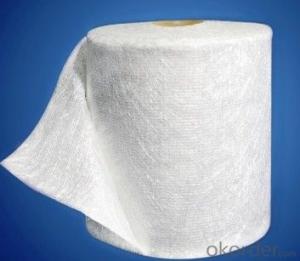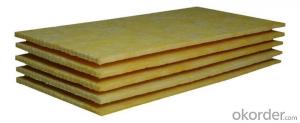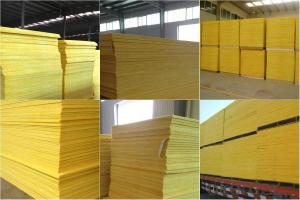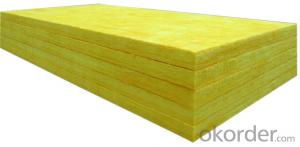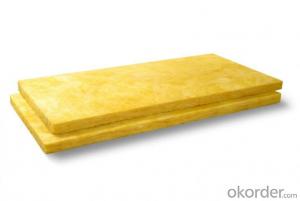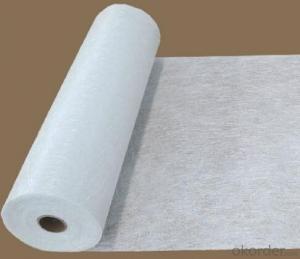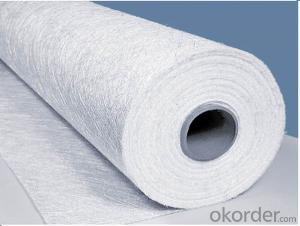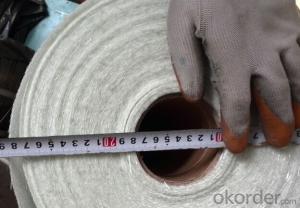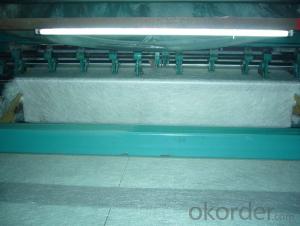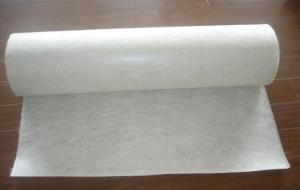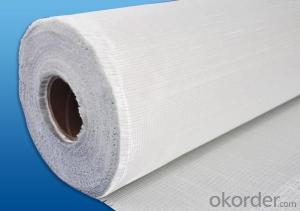Fiberglass Mat Tissue E-Glass Stitched Chopped Strand Mat for FRP Boat and Tube
- Loading Port:
- China Main Port
- Payment Terms:
- TT or LC
- Min Order Qty:
- -
- Supply Capability:
- -
OKorder Service Pledge
OKorder Financial Service
You Might Also Like
1.Brief Introduction
E Glass Stitched Chopped Mat is made by chopping continuous strands into chopped strands and stitching them together. The product has a maximum width of 110 inches. The products can be used in various fields,such as FRP industry.
2.Product Features
Fast breakdown in styrene
Good wet-through and fast wet-out in resins, rapid air lease
Cost saving and worthwhile.
3.Product Specifications
Item | Over Density | Moisture Content | Chop Density | Polyester Yarn | Width |
(g/m2) | (%) | (g/m2) | (g/m2) | (mm) | |
EMK300 | 309.5 | ≤0.15 | 300 | 9.5 | 50-3300 |
EMK380 | 399 | 380 | 19 | ||
EMK450 | 459.5 | 450 | 9.5 | ||
EMK450 | 469 | 450 | 19 | ||
EMC0020 | 620.9 | 601.9 | 19 | ||
EMC0030 | 909.5 | 900 | 9.5 |
Special specification can be produce according to customer requirements.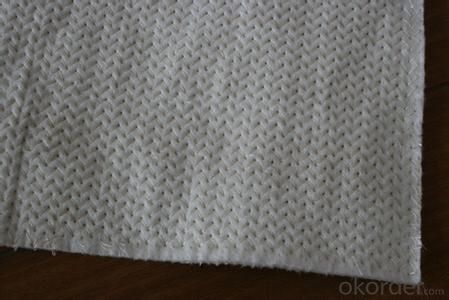
4.FAQ
Storage:
Unless otherwise specified, E-Glass Stitched Chopped Strand Mat should be stored in a dry, cool and rain-proof area. It is recommended that the room temperature and humidity should be always maintained at 15℃~35℃ and 35%~65% respectively.
- Q: Can fiberglass mat tissue be used for acoustic insulation?
- Yes, fiberglass mat tissue can be used for acoustic insulation. It is a commonly used material for soundproofing due to its ability to absorb and dampen sound waves. Its high density and fibrous structure make it effective in reducing noise and improving acoustic performance in buildings, vehicles, and other applications.
- Q: Is fiberglass mat tissue suitable for wastewater treatment applications?
- Yes, fiberglass mat tissue is suitable for wastewater treatment applications. It is commonly used in the construction of wastewater treatment tanks and pipes due to its corrosion resistance, durability, and ability to withstand harsh chemical environments. Additionally, fiberglass mat tissue is non-reactive to biological and chemical elements present in wastewater, making it an ideal material for such applications.
- Q: What is fiberglass mat tissue?
- Fiberglass mat tissue is a type of non-woven material made from glass fibers that are randomly oriented and bonded together with a binder. It is commonly used in various industries, including construction, automotive, and aerospace. The main purpose of fiberglass mat tissue is to provide strength, durability, and reinforcement to composite materials. It acts as a supporting layer between the resin and the glass fibers, helping to distribute stress and improve the overall mechanical properties of the final product. Fiberglass mat tissue has several advantages over other materials. It is lightweight, flexible, and easy to handle, making it ideal for applications that require complex shapes or curved surfaces. It also has excellent resistance to chemicals, moisture, and temperature changes, ensuring its longevity in harsh environments. In construction, fiberglass mat tissue is often used in the production of roofing materials, wall panels, and insulation boards. Its high strength-to-weight ratio makes it a popular choice for reinforcing concrete structures, such as bridges and buildings. In the automotive industry, fiberglass mat tissue is used in the manufacturing of car parts, such as body panels, bumpers, and interior components. It can enhance the structural integrity of these parts, making them more resistant to impacts and vibrations. In the aerospace industry, fiberglass mat tissue is employed in the production of aircraft components, such as wings, fuselages, and interiors. Its lightweight nature contributes to fuel efficiency and overall weight reduction, while still maintaining the necessary strength for safe flight. Overall, fiberglass mat tissue is a versatile and reliable material that plays a crucial role in enhancing the performance, durability, and safety of various products in different industries. Its unique properties make it an indispensable component in the production of composite materials.
- Q: Is fiberglass mat tissue suitable for automotive body panel repairs?
- Indeed, automotive body panel repairs can be successfully carried out using fiberglass mat tissue. This material, known for its robustness, endurance, and adaptability, is widely employed in automotive repairs. Its exceptional ability to conform to the distinctive curves of a vehicle makes it particularly effective in fixing body panels. Moreover, fiberglass mat tissue boasts resistance against corrosion, moisture, and chemicals, rendering it a prime selection for automotive purposes. Furthermore, its lightweight nature aids in reducing the overall weight of the vehicle, thereby enhancing fuel efficiency. All in all, fiberglass mat tissue proves to be a dependable and efficient choice for automotive body panel repairs.
- Q: How does fiberglass mat tissue perform in terms of mold and mildew resistance?
- Fiberglass mat tissue possesses exceptional mold and mildew resistance. Its inherent moisture resistance prevents the proliferation of mold and mildew. Moreover, fiberglass is impermeable and unsuitable for the flourishing of these microorganisms. Furthermore, fiberglass mat tissue finds extensive usage in areas with high humidity, like bathroom walls or showers, and has proven highly efficient in deterring mold and mildew growth. All in all, fiberglass mat tissue exhibits outstanding performance in terms of mold and mildew resistance, rendering it a dependable option for situations where these issues are prominent.
- Q: How does fiberglass mat tissue perform in terms of thermal expansion?
- Fiberglass mat tissue has a relatively low thermal expansion coefficient, meaning it expands minimally when exposed to heat. This characteristic makes it an excellent material for applications where thermal stability is crucial. The tightly woven structure of fiberglass mat tissue helps to limit the expansion and contraction of the material, even under high temperatures. Consequently, it exhibits excellent dimensional stability and resistance to thermal stresses. This property allows fiberglass mat tissue to maintain its structural integrity when exposed to extreme temperature variations, making it highly suitable for use in industries such as aerospace, automotive, and construction, where thermal expansion and contraction can pose significant challenges.
- Q: Can fiberglass mat tissue be used for insulation in hot climates?
- Yes, fiberglass mat tissue can be used for insulation in hot climates. Fiberglass is known for its excellent thermal insulation properties, which make it suitable for both hot and cold climates. In hot climates, fiberglass insulation helps to prevent the transfer of heat from outside to the inside of a building, thus maintaining a comfortable indoor temperature. It acts as a barrier by reducing the heat transfer through conduction, convection, and radiation. Additionally, fiberglass insulation is fire-resistant, durable, and does not absorb moisture, making it an ideal choice for insulation in hot climates.
- Q: How does the fiber content of fiberglass mat tissue affect its strength?
- The fiber content of fiberglass mat tissue directly affects its strength. The higher the fiber content, the stronger the fiberglass mat tissue will be. This is because the fibers provide the structural integrity and reinforcement to the material. When the fiber content is increased, it results in a higher concentration of fibers, which in turn increases the overall strength of the tissue. Fiberglass mat tissue is composed of glass fibers that are randomly oriented and bound together with a resin binder. These fibers are responsible for carrying the load and providing resistance to any external forces or stresses applied to the material. As a result, the more fibers present in the tissue, the greater the load-carrying capacity and strength of the material. Additionally, a higher fiber content enhances the stiffness of the fiberglass mat tissue. Stiffness refers to the ability of a material to resist deformation or bending under applied loads. With a greater amount of fibers, the tissue becomes stiffer, making it less prone to bending or flexing. This increased stiffness contributes to the overall strength of the material. It is important to note that while a higher fiber content improves the strength of fiberglass mat tissue, there is an optimal range where the benefits of additional fibers are maximized. Beyond this range, the increased fiber content may not result in a significant improvement in strength, and it may have diminishing returns. Therefore, it is crucial to find the right balance between fiber content and strength for specific applications. In conclusion, the fiber content of fiberglass mat tissue directly impacts its strength. Increasing the fiber content leads to a higher concentration of fibers, which enhances the material's load-carrying capacity and stiffness. Finding the optimal fiber content is essential to maximize the strength of the tissue for specific applications.
- Q: How does fiberglass mat tissue compare to cellulose insulation?
- Fiberglass mat tissue and cellulose insulation differ in terms of material composition and insulation properties. Fiberglass mat tissue is made from fine glass fibers, while cellulose insulation is composed of recycled paper fibers treated with fire-retardant chemicals. Fiberglass mat tissue offers higher R-value, meaning it provides better thermal insulation and energy efficiency. Additionally, it is resistant to moisture and does not promote mold growth. On the other hand, cellulose insulation is more affordable, environmentally friendly, and provides better sound insulation. Ultimately, the choice between the two depends on specific insulation needs, budget, and environmental considerations.
- Q: Can fiberglass mat tissue be used for interior decoration?
- Yes, fiberglass mat tissue can be used for interior decoration. Fiberglass mat tissue is a versatile material that can be used for various purposes, including interior decoration. It is commonly used as a reinforcement material for composite materials, such as fiberglass reinforced plastic (FRP), which can be used to create decorative elements like panels, wall coverings, and moldings. Fiberglass mat tissue is lightweight, durable, and has excellent strength and resistance to moisture and chemicals. It can be easily molded into different shapes and designs, making it a popular choice for interior decoration projects. Additionally, fiberglass mat tissue can be coated or painted to match any desired color or texture, allowing for a wide range of creative possibilities in interior design.
Send your message to us
Fiberglass Mat Tissue E-Glass Stitched Chopped Strand Mat for FRP Boat and Tube
- Loading Port:
- China Main Port
- Payment Terms:
- TT or LC
- Min Order Qty:
- -
- Supply Capability:
- -
OKorder Service Pledge
OKorder Financial Service
Similar products
Hot products
Hot Searches
Related keywords
